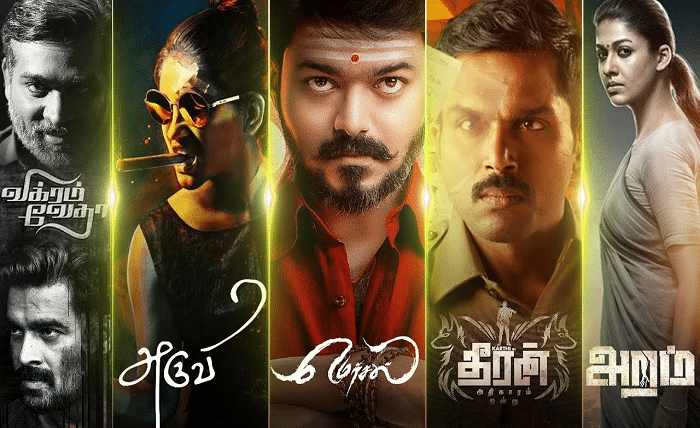Tamil Movies: A Rich Tapestry of Culture, Cinema, and Storytelling

Tamil movies, an integral part of the Indian cinema industry, have evolved over decades, captivating audiences with their storytelling, music, and performance. With a rich history that spans more than a century, Tamil cinema, or Kollywood, has produced numerous iconic films that resonate not only with local audiences but also with film enthusiasts across the globe. This blog delves into the journey of Tamil movies, their cultural significance, and what makes them stand out in the world of cinema.
The Origins of Tamil Movies
Tamil movies originated in the early 20th century, laying the foundation for one of India’s most prolific film industries. The first Tamil silent film, Keechaka Vadham, was released in 1916, marking the beginning of Tamil cinema. Over time, Tamil movies grew in popularity, and with the advent of sound, the industry began to flourish. The introduction of Tamil talkies in the 1930s allowed filmmakers to explore deeper narratives, social issues, and complex characters, making Tamil movies an essential part of Indian cultural expression.
The Golden Age of Tamil Movies
The 1950s to the 1970s are often referred to as the golden age of Tamil movies. During this period, films such as Parasakthi, Manohara, and Anbe Vaa became classics, resonating with both the masses and critics. This era saw the rise of legendary actors like M.G. Ramachandran (MGR) and Sivaji Ganesan, whose performances became benchmarks for future generations of actors. Tamil movies from this period were known for their strong narrative, intense drama, and social messages, making them timeless pieces of art.
The Evolution of Music in Tamil Movies
Music has always been a defining element of Tamil movies. From classical Carnatic influences in the early days to the contemporary beats of today’s hits, Tamil movie soundtracks have continuously evolved. The introduction of legendary composers like Ilaiyaraaja and A.R. Rahman revolutionized Tamil movies’ music industry, offering a unique blend of traditional and modern sounds. Today, music in Tamil movies plays a significant role in their success, often becoming chart-topping hits even before the films are released.
The Role of Technology in Tamil Movies
With advancements in technology, Tamil movies have experienced tremendous growth in terms of visual and sound quality. From black-and-white films to high-definition digital films, the transition has been remarkable. The introduction of CGI, VFX, and Dolby sound systems has transformed Tamil movies, enabling filmmakers to produce visually stunning and technically superior films. Recent blockbusters like Enthiran and 2.0 are prime examples of how technology has elevated Tamil movies to international standards.
The Influence of Tamil Movies on Indian Cinema
Tamil movies have had a profound influence on Indian cinema. Many successful Bollywood films are remakes of Tamil movies, showcasing the industry’s innovative storytelling and fresh ideas. Filmmakers like Mani Ratnam, Shankar, and K. Balachander have brought Tamil movies to national prominence, influencing filmmakers across India. The unique blend of commercial entertainment and meaningful storytelling in Tamil movies has inspired countless filmmakers to adapt similar styles in other regional cinemas.
Women in Tamil Movies: A Journey of Empowerment
Tamil movies have portrayed women in diverse roles, evolving from stereotypical characters to more empowered and complex figures. In the early days, female characters were often confined to traditional roles. However, modern Tamil movies have begun portraying women as independent, strong, and multi-dimensional characters. Films like Aramm, 36 Vayadhinile, and Magalir Mattum highlight the importance of women-centric narratives in Tamil movies, challenging societal norms and inspiring change.
The Global Reach of Tamil Movies
In recent years, Tamil movies have gained international recognition, with films like Super Deluxe and Karnan being screened at prestigious film festivals across the world. Tamil cinema’s global reach is also reflected in the growing number of Tamil movies being dubbed into other languages or remade in different film industries. Streaming platforms such as Netflix and Amazon Prime have played a crucial role in bringing Tamil movies to global audiences, allowing people from diverse backgrounds to appreciate the richness of Tamil storytelling.
Tamil Movies and the Rise of Independent Filmmakers
In addition to mainstream cinema, Tamil movies have also seen the rise of independent filmmakers who are redefining storytelling in the industry. Directors like Karthik Subbaraj and Thiagarajan Kumararaja have challenged conventional filmmaking techniques, focusing on raw, realistic narratives and pushing the boundaries of Tamil movies. These independent films, often made on smaller budgets, are gaining popularity for their fresh perspectives and unique storytelling styles, proving that Tamil cinema is not limited to just commercial films.
The Importance of Comedy in Tamil Movies
Comedy has always played a significant role in Tamil movies, adding an element of humor and light-heartedness to otherwise intense narratives. Tamil cinema is known for its talented comedians such as Goundamani, Senthil, and Vadivelu, whose comedic timing and relatable humor have won the hearts of audiences. In modern Tamil movies, comedy continues to be a key element, with actors like Santhanam and Yogi Babu bringing a new wave of humor to the silver screen.
The Future of Tamil Movies
As Tamil movies continue to evolve, the future looks promising for Kollywood. With a mix of commercial hits and critically acclaimed films, Tamil cinema is thriving, offering a platform for new voices and innovative storytelling. The use of advanced technology, coupled with a focus on diverse narratives, will ensure that Tamil movies remain relevant and continue to captivate audiences worldwide. The global demand for Tamil movies is also expected to grow, with more international collaborations and cross-industry remakes on the horizon.
Looking for the perfect Saturday Good Morning images to kickstart your weekend? Explore our handpicked collection of vibrant, cheerful, and heartwarming images to share with your loved ones. Whether you want to spread positivity, send warm wishes, or simply uplift someone’s day, these images are perfect for every Saturday morning. From serene nature scenes to motivational quotes, our gallery offers something for everyone. Start your Saturday with a smile and make others feel special too. Discover the joy of sharing happiness—one image at a time. Browse now and brighten your weekend mornings!
Conclusion
Tamil movies have come a long way since their inception, continuously evolving with the times while maintaining their cultural roots. From the golden age of cinema to modern-day blockbusters, Tamil movies have consistently delivered captivating stories, memorable performances, and chart-topping music. As Tamil cinema continues to expand its horizons, both locally and globally, it remains a vital part of India’s cinematic heritage. Whether you’re a long-time fan or a newcomer to Tamil movies, the rich legacy and bright future of this industry offer something for everyone.
Explore courselinkfree.us for free online courses across various subjects. Learn at your own pace with high-quality content, accessible to everyone. Start enhancing your skills with Courselinkfree.us today!
FAQs
1. What makes Tamil movies unique compared to other regional cinemas?
Tamil movies are known for their strong narratives, innovative storytelling, and a perfect blend of commercial entertainment and meaningful cinema, which sets them apart from other regional industries.
2. Who are some of the most influential directors in Tamil cinema?
Directors like Mani Ratnam, Shankar, and K. Balachander have been instrumental in shaping Tamil cinema, with their innovative techniques and groundbreaking films.
3. How has Tamil cinema evolved over the years?
Tamil cinema has evolved significantly in terms of technology, storytelling, and music, from the early days of black-and-white silent films to today’s high-budget, visually spectacular movies.
4. How has technology impacted Tamil movies?
Advances in technology have greatly enhanced the visual and auditory experience in Tamil movies, with CGI, VFX, and digital sound systems playing a key role in recent blockbusters.
5. Are Tamil movies popular internationally?
Yes, Tamil movies are gaining international recognition, with many being screened at global film festivals and available on popular streaming platforms for audiences worldwide.
Discover vedu app a cutting-edge platform offering seamless video streaming, real-time content sharing, and interactive learning. Explore its features and enhance your digital experience with Vedu.





